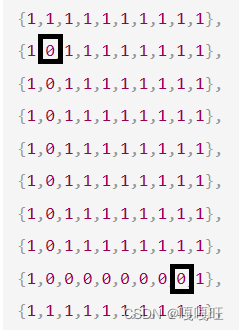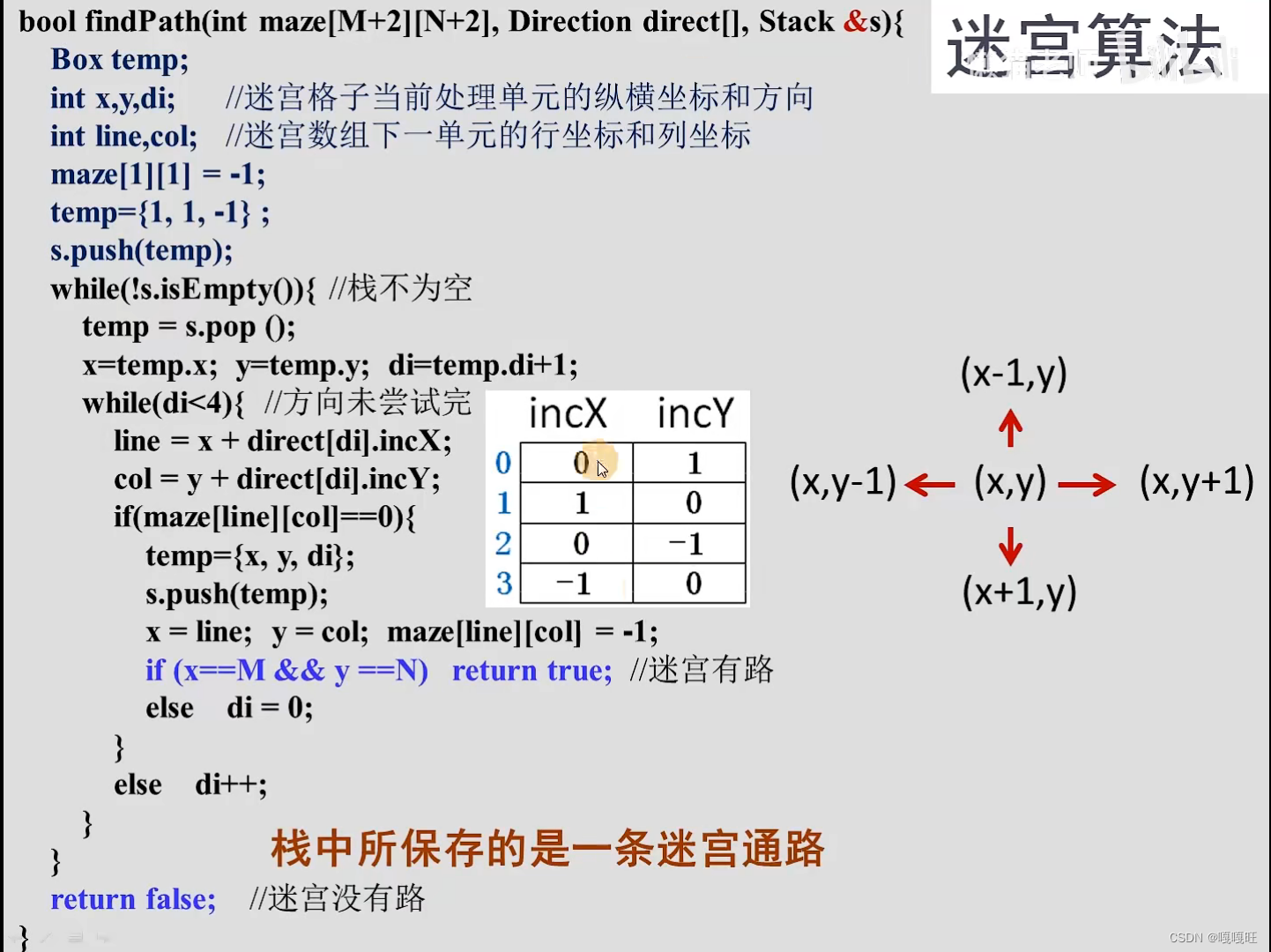1.问题展示

2.栈的所有有用的函数
因为要用栈实现,所以我们必须将有关栈的函数全部写出来,我们已经之前写过栈的初始化,等等,,我们将他拷贝过来,或者你们直接去看我那一篇。
//栈的实现
#include <stdio.h>
#include <assert.h>
#include <stdlib.h>
typedef struct stack//定义一个栈的结构体变量
{
int * a;
int top; // 栈顶
int capacity; // 容量
}stack;
void stackinit(stack* ps)
{
assert(ps);//断言,防止为空指针
ps->a = null;//所指向的地址为空
ps->capacity = ps->top = 0;//容量和栈中元素个数均为0
}
void stackpush(stack* ps, int data)
{
assert(ps);
if (ps->capacity == ps->top)//如果栈中的元素个数等于栈的容量时考虑扩容,
{
int newcapcity = ps->capacity == 0 ? 4 : ps->capacity * 2;//如果刚开始时都等于0,就先给4个空间大小,后面如果满的话,容量扩大1倍
int* newnode = (int*)realloc(ps->a,sizeof(int)* newcapcity);//申请空间,将申请好的空间首地址传给newnode指针
assert(newnode);//断言,防止malloc失败
ps->a = newnode;//将newnode保存的申请空间的首地址传给ps->a,让ps->a指向创建好的空间
ps->capacity = newcapcity;//容量大小更新为新容量大小
}
ps->a[ps->top] = data;//像存数组一样存数据
ps->top++;//指向下一个
}
// 检测栈是否为空,如果为空返回非零结果,如果不为空返回0
int stackempty(stack* ps)
{
assert(ps);
return ps->top ==0;//ps->top为栈中元素个数.==0栈中无元素,无元素要返回1, 无元素ps->t0p==0,这个表达式结果是1,返回1;
}
// 出栈
void stackpop(stack* ps)
{
assert(ps);
assert(!stackempty(ps));//防止栈内无元素,继续出栈
ps->top--;
}
// 获取栈顶元素
int stacktop(stack* ps)
{
assert(ps);
assert(!stackempty(ps));
return ps->a[ps->top - 1];//ps->top为栈中元素个数,由于数组下标是从0开始,所以栈顶元素下标为ps->top-1;
}
// 获取栈中有效元素个数
int stacksize(stack* ps)
{
assert(ps);
return ps->top;
}
// 销毁栈
void stackdestroy(stack* ps)
{
assert(ps);
free(ps->a);//free掉动态申请的内存
ps->a = null;//防止野指针
ps->capacity = ps->top = 0;//容量和栈中元素个数置为0
}
但是不能直接用,所以我们必须加以修改,我们会将从入口到出口正确的路径坐标,以及每个坐标对应走向下一个坐标的方向保存在栈里面,由我之前实现的栈中一个元素变为三个元素,栈的实现做出以下改变,int * a,a指针不在指向一个int ,将inta改为proa;pro为结构体类型存放三个元素
typedef struct pro
{
int x;
int y;
int di;
}pro;
typedef struct stack
{
pro* a;
int top; // 栈顶
int capacity; // 容量
}stack;
void stackpush(stack* ps, int data1, int data2, int data3)//入栈
{
assert(ps);
if (ps->capacity == ps->top)
{
int newcapcity = ps->capacity == 0 ? 4 : ps->capacity * 2;
pro* tmp = (pro*)realloc(ps->a, sizeof(pro) * newcapcity);
if (tmp == null)
{
perror("realloc fail");
}
else
{
ps->a = tmp;
ps->capacity = newcapcity;
}
}
ps->a[ps->top].x = data1;
ps->a[ps->top].y = data2;
ps->a[ps->top].di = data3;
ps->top++;
}
由于每层由之前一个元素变为三个元素,所以要修改获取栈顶元素函数,返回栈顶地址,然后通过地址来访问三个元素中的每一个
// 获取栈顶元素
pro* stacktop(stack* ps)
{
assert(ps);
assert(!stackempty(ps));
return ps->a+ps->top-1;
}
3.修改后的栈的实现
typedef struct pro
{
int x;
int y;
int di;
}pro;
typedef struct stack
{
pro* a;
int top; // 栈顶
int capacity; // 容量
}stack;
void stackinit(stack* ps)//初始化栈
{
ps->a = null;
ps->top = 0;
ps->capacity = 0;
}
void stackpush(stack* ps, int data1, int data2, int data3)//入栈
{
assert(ps);
//assert(ps->a);
if (ps->capacity == ps->top)
{
int newcapcity = ps->capacity == 0 ? 4 : ps->capacity * 2;
pro* tmp = (pro*)realloc(ps->a, sizeof(pro) * newcapcity);
if (tmp == null)
{
perror("realloc fail");
}
else
{
ps->a = tmp;
ps->capacity = newcapcity;
}
}
ps->a[ps->top].x = data1;
ps->a[ps->top].y = data2;
ps->a[ps->top].di = data3;
ps->top++;
}
// 检测栈是否为空,如果为空返回非零结果,如果不为空返回0
int stackempty(stack* ps)
{
assert(ps);
return ps->top == 0;
}
// 出栈
void stackpop(stack* ps)
{
assert(ps);
assert(!stackempty(ps));
ps->top--;
}
// 获取栈顶元素
pro* stacktop(stack* ps)
{
assert(ps);
assert(!stackempty(ps));
return ps->a+ps->top-1;
}
// 获取栈中有效元素个数
int stacksize(stack* ps)
{
assert(ps);
return ps->top;
}
// 销毁栈
void stackdestroy(stack* ps)
{
assert(ps);
free(ps->a);
ps->a = null;
ps->top = ps->capacity = 0;
}
4. 定义二维数组作为迷宫的地图
我们这里将1看做墙,0看做空地可以走的地方,然后迷宫入口坐标为(1,1),我们定义二维数组为m*n的
#define n 10
#define m 10
迷宫出口坐标为(m-2,n-2);
定义全局变量,方便使用
int map[m][n] = {
{1,1,1,1,1,1,1,1,1,1},
{1,0,1,1,1,1,1,1,1,1},
{1,0,1,1,1,1,1,1,1,1},
{1,0,1,1,1,1,1,1,1,1},
{1,0,1,1,1,1,1,1,1,1},
{1,0,1,1,1,1,1,1,1,1},
{1,0,1,1,1,1,1,1,1,1},
{1,0,1,1,1,1,1,1,1,1},
{1,0,0,0,0,0,0,0,0,1},
{1,1,1,1,1,1,1,1,1,1},
};

黑框标注的分别为入口和出口.
在定义一个结构体,表示要走的方向
typedef struct direct
{
int conx;
int cony;
}direct;
在主函数里面定义一个direct类型的数组,数组大小为四,存放上下左右走,坐标的变化,并且将他们赋值
direct des[4];
des[0].conx = 1;//向右走
des[0].cony = 0;
des[1].conx = -1;//向左走
des[1].cony = 0;
des[2].conx = 0;//向下走
des[2].cony = 1;
des[3].conx = 0;//向上走
des[3].cony = -1;

向哪走就给对应坐标+上什么的,比如说我向右走,x+des[0].conx ,y+des[0].cony;
5.定义一个栈,将其初始化,当用完时候将其销毁
int main()
{
direct des[4];
des[0].conx = 1;//向右走
des[0].cony = 0;
des[1].conx = -1;//向左走
des[1].cony = 0;
des[2].conx = 0;//向下走
des[2].cony = 1;
des[3].conx = 0;//向上走
des[3].cony = -1;
stack st;
stackinit(&st);
stackdestroy(&st);
stackdestroy(&scpy);
return 0;
}
6. dfs算法寻找迷宫是否有通路

bool findpath(int map[][n], direct des[], stack* ps)
{
int line, col;//表示当前位置能走的下一个位置的坐标
int x, y, di;//表示当前位置的坐标,以及当前位置准备向下一个方向走的方向
int mapcon[m][n] = { 0 };//为了不修改原有的地图,重新创建一个二维数组
for (int i = 0; i < m; i++)//遍历地图,将原地图的二维数组的值拷贝到mapcon中
{
for (int j = 0; j < n; j++)
{
mapcon[i][j] = map[i][j];
}
}
mapcon[1][1] = -1;//走过的地方用-1标记
pro tmp;//保存当前位置的坐标,以及方向
tmp.x = 1;
tmp.y = 1;
tmp.di = -1;//刚开始在(1,1),将tmp.x,tmp.y赋值为1,刚开始还没有方向tmp.di = -1;
stackpush(ps, tmp.x, tmp.y, tmp.di);//将当前位置信息压入st栈中
while (!stackempty(ps))//栈中不为空,开始循环
{
tmp.x = stacktop(ps)->x;
tmp.y = stacktop(ps)->y;
tmp.di = stacktop(ps)->di;//获取栈顶元素到tmp中去,以便于回退
stackpop(ps);//出栈操作
x = tmp.x;//当前坐标改为回退之后的坐标
y = tmp.y;//当前坐标改为回退之后的坐标
di = tmp.di + 1;//开始di=0,方向向右
while (di < 4)//遍历当前位置的四个方向
{
line = x + des[di].conx;//记录下一个位置的坐标
col = y + des[di].cony;//记录下一个位置的坐标
if (mapcon[line][col] == 0)//如果下一个坐标时0,为空地的话,就可以前进
{
tmp.x = x;//保存当前位置坐标,以便于回退
tmp.y = y;//保存当前位置坐标,以便于回退
tmp.di = di;//保存当前位置坐标,以便于回退
stackpush(ps, tmp.x, tmp.y, tmp.di);//当前位置目前确定是通往出口路上的一个坐标,先入栈
x = line;//当前位置更新为下一个位置的坐标
y = col;//当前位置更新为下一个位置的坐标
mapcon[line][col] = -1;//留下足迹,标记为-1;
if (x == m - 2 && y == n - 2)//是否到出口
return true;//有通路,跳出
else di = 0;//没到的话,将方向更新为向右
}
else di++;//如果当前位置的方向不是空地的话,就换另一个方向判断
}
}
return false;//循环结束,无通路
}
7. 逆序打印坐标
如果有通路的话, findpath()函数返回1,由于栈是先入后出,所以栈顶元素是出口的坐标,怎么逆序打印从入口到出口的坐标呢?我们可以在创建一个栈,使用栈判空函数循环将st中的元素入栈到另一个栈中,就做到了在原先栈底元素,跑到了新栈的栈顶,实现了逆序打印

stack st;
stack scpy;//定义一个栈用于倒翻数据
stackinit(&st);
stackinit(&scpy);//新栈初始话
bool ret = findpath(map, des, &st);//返回1,地图有通路
if (ret == 1)
{
printf("该地图有通路\n");
while (!stackempty(&st))//原栈不为空的话
{
int num1=stacktop(&st)->x;
int num2 = stacktop(&st)->y;
int num3= stacktop(&st)->di;//获取旧栈栈顶元素
/*printf("%d-%d ",num1,num2);*/
stackpop(&st);//栈顶元素出st栈
stackpush(&scpy, num1, num2, num3);//栈顶元素入新栈scpy
}
while (!stackempty(&scpy))//新栈scpy不为空,
{
int num1 = stacktop(&scpy)->x;
int num2 = stacktop(&scpy)->y;
int num3 = stacktop(&scpy)->di;//获取栈顶元素
printf("(%d,%d)\n", num1, num2);//打印栈顶元素
stackpop(&scpy);//新栈栈顶元素出栈
}
}
else
{
printf("该地图无通路\n");
}
stackdestroy(&st);//销毁旧栈
stackdestroy(&scpy);//销毁新栈
只打印坐标,不要求方向,我就在栈中没画方向.
8.整体代码
#include <stdio.h>
#include <assert.h>
#include <stdlib.h>
#include <stdbool.h>
#define n 10
#define m 10
int map[m][n] = {
{1,1,1,1,1,1,1,1,1,1},
{1,0,1,1,1,1,1,1,1,1},
{1,0,1,1,1,1,1,1,1,1},
{1,0,1,1,1,1,1,1,1,1},
{1,0,1,1,1,1,1,1,1,1},
{1,0,1,1,1,1,1,1,1,1},
{1,0,1,1,1,1,1,1,1,1},
{1,0,1,1,1,1,1,1,1,1},
{1,0,0,0,0,0,0,0,0,1},
{1,1,1,1,1,1,1,1,1,1},
};
typedef struct pro
{
int x;
int y;
int di;
}pro;
typedef struct direct
{
int conx;
int cony;
}direct;
typedef struct stack
{
pro* a;
int top; // 栈顶
int capacity; // 容量
}stack;
void stackinit(stack* ps)//初始化栈
{
ps->a = null;
ps->top = 0;
ps->capacity = 0;
}
void stackpush(stack* ps, int data1, int data2, int data3)//入栈
{
assert(ps);
//assert(ps->a);
if (ps->capacity == ps->top)
{
int newcapcity = ps->capacity == 0 ? 4 : ps->capacity * 2;
pro* tmp = (pro*)realloc(ps->a, sizeof(pro) * newcapcity);
if (tmp == null)
{
perror("realloc fail");
}
else
{
ps->a = tmp;
ps->capacity = newcapcity;
}
}
ps->a[ps->top].x = data1;
ps->a[ps->top].y = data2;
ps->a[ps->top].di = data3;
ps->top++;
}
// 检测栈是否为空,如果为空返回非零结果,如果不为空返回0
int stackempty(stack* ps)
{
assert(ps);
return ps->top == 0;
}
// 出栈
void stackpop(stack* ps)
{
assert(ps);
assert(!stackempty(ps));
ps->top--;
}
// 获取栈顶元素
pro* stacktop(stack* ps)
{
assert(ps);
assert(!stackempty(ps));
return ps->a+ps->top-1;
}
// 获取栈中有效元素个数
int stacksize(stack* ps)
{
assert(ps);
return ps->top;
}
// 销毁栈
void stackdestroy(stack* ps)
{
assert(ps);
free(ps->a);
ps->a = null;
ps->top = ps->capacity = 0;
}
enum mine
{
space, //空地
wall,//墙
dest, //目的地
player//玩家
};
bool findpath(int map[][n], direct des[], stack* ps)
{
int line, col;
int x, y, di;
int mapcon[m][n] = { 0 };
for (int i = 0; i < m; i++)
{
for (int j = 0; j < n; j++)
{
mapcon[i][j] = map[i][j];
}
}
mapcon[m - 2][n - 2] = 0;
mapcon[1][1] = -1;
pro tmp;
tmp.x = 1;
tmp.y = 1;
tmp.di = -1;
stackpush(ps, tmp.x, tmp.y, tmp.di);
while (!stackempty(ps))
{
tmp.x = stacktop(ps)->x;
tmp.y = stacktop(ps)->y;
tmp.di = stacktop(ps)->di;
stackpop(ps);
x = tmp.x;
y = tmp.y;
di = tmp.di + 1;
while (di < 4)
{
line = x + des[di].conx;
col = y + des[di].cony;
if (mapcon[line][col] == 0)
{
tmp.x = x;
tmp.y = y;
tmp.di = di;
stackpush(ps, tmp.x, tmp.y, tmp.di);
x = line;
y = col;
mapcon[line][col] = -1;
if (x == m - 2 && y == n - 2)
return true;
else di = 0;
}
else di++;
}
}
return false;
}
int main()
{
srand((unsigned int)time(null));
direct des[4];
des[0].conx = 1;//向右走
des[0].cony = 0;
des[1].conx = -1;//向左走
des[1].cony = 0;
des[2].conx = 0;//向下走
des[2].cony = 1;
des[3].conx = 0;//向上走
des[3].cony = -1;
stack st;
stack scpy;
stackinit(&st);
stackinit(&scpy);
bool ret = findpath(map, des, &st);
if (ret == 1)
{
printf("该地图有通路\n");
while (!stackempty(&st))
{
int num1=stacktop(&st)->x;
int num2 = stacktop(&st)->y;
int num3= stacktop(&st)->di;
/*printf("%d-%d ",num1,num2);*/
stackpop(&st);
stackpush(&scpy, num1, num2, num3);
}
while (!stackempty(&scpy))
{
int num1 = stacktop(&scpy)->x;
int num2 = stacktop(&scpy)->y;
int num3 = stacktop(&scpy)->di;
printf("(%d,%d)\n", num1, num2);
stackpop(&scpy);
}
}
else
{
printf("该地图无通路\n");
}
stackdestroy(&st);
stackdestroy(&scpy);
return 0;
}
9.编译运行






发表评论